Benefits of Vermiculture
Beginning from 1995, in all documented trials conducted by Morarka Foundation, the users have been requested to rate the performance of vermicast. Each farmer has been requested to list three most important benefits derived by the use of vermicast. The summary analysis of benefits in the order of priorities reported by the farmers is given below:
Benefits in Agriculture during Phase-I of Vermiculture Development
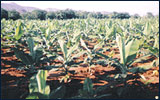
• Additional price gain from the sale of farm produce
• Better taste of food
• Bigger size of farm produce
• Less irrigation water requirement
• Cultivation became possible in saline-alkaline conditions
Initially most of the vermicast was produced as an on-farm input.
Benefits in Agriculture during Phase-II of Vermiculture Development
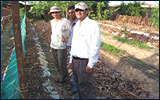
• Significantly more tillering, flowering and grain setting
• Less insects and pests attack on crops after consistent use of vermicast
• Less weed infestation as compared to farm yard manure
With better understanding of vermicast applications, many more benefits were observed.
Benefits in Agriculture during Phase-III of Vermiculture Development
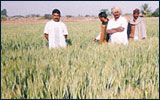
• Substituted chemical inputs ranging from 30-100 percent.
• Reduced cost of cultivation ranging from 40-50 percent.
• Increased productivity by 20-40 percent.
Over the years, vermicast established its hardcore benefits in agriculture.
Benefits in Landscapes, Gardens and Nurseries
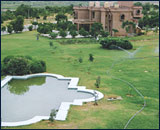
• It reduces water consumption.
• It improves the quality and appearance.
• It reduces the bulk (as compared to FYM).
• It eliminates the need for weeding operations.
• It increases the shelf life of flowers.
• It improves germination of seeds in nurseries.
Many benefits of vermicast have already made it to be a principal fertility management input for landscapes, gardens and nurseries.Many benefits of vermicast have already made it to be a principal fertility management input for landscapes, gardens and nurseries.
Benefits in Soil and Water Conservation
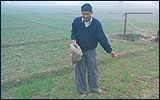
• It helps in stabilization of earthen structures through better vegetative growth.
• It promotes grass production in degraded open grass lands.
• Enables reclamation of waste lands for plantation & cultivation.
Vermicast applications has reduced cost of reclamation by 40-50 percent for waste lands.
Benefits in Plantation of Trees
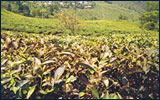
• Helps in early stabilization of transplants.
• Enables early regeneration of partly degraded forest areas.
• Increases overall vegetation in hilly regions.
Vermicast has improved plants survival rates from average 40 percent to over 85 percent in most cases.
Comparison between Vermicast V/s. Chemical Fertilizers
Criteria for
Comparison |
Chemical Fertilizers |
Vermicast |
| Macro nutrient contents |
Mostly contains only one (N in urea) or at the most two (N & P in DAP) nutrients in any one type of chemical fertilizer |
Contains all i.e. nitrogen (N), phosphorus (P) & potassium (K) in sufficient quantities |
| Secondary nutrient contents |
Not available |
Calcium (Ca), magnesium (Mg) & sulphur (S) is available in required quantities |
| Micro nutrient contents |
Not available |
Zinc (Zn), boron (B), manganese ( Min), iron (Fe), copper (Cu), molybdenum (Mo) and chlorine (CI) also present |
| pH balancing |
Disturb soil pH to create salinity and alkalinity conditions |
Helps in the control of soil pH and checks the salinity and alkalinity in soil |
| EC correction |
Creates imbalance in soil EC Affecting nutrients assimilation |
Helps in balancing the EC to improve plant nutrient adsorption |
| Organic carbon |
Not available |
Very high organic carbon and humus contents improves soil characteristics |
| Moisture retention capacity |
Reduces moisture retention Capacity of the soil |
Increases moistures retention capacity of the soil |
| Soil Texture |
Damages soil texture to reduce aeration |
Improves soil texture for better aeration |
| Beneficial bacteria fungi |
Reduces biological activities and Thus the fertility is impaired |
Very high biological life improves the soil fertility and productivity on sustainable basis |
| Plant growth hormones |
Not available |
Sufficient quantity helps in better growth and production |
Vermiculture Business Development
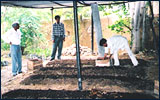
The success of vermiculture development has been entirely due to its business viability. In the initial years beginning with a very small investment of only Rs. 5,000/-, over the years entrepreneurs have come forward to setup large scale commercial units with investment upto Rs. 5,000,000/-. By and large a majority of the business units have been able to recover their investments in 1-3 years time.
Business development plan for commercial units can be provided on demand.
Vermicast Application In Agriculture
The entire technology development of vermiculture in partnership with farmers enabled its applications development almost simultaneously. Based on thousands of monitored trials conducted for about ten years and in almost all 15 agro-climatic zones of India, we have developed vermicast applications in following categories:
Based on previous use of chemical fertilizers
• very high chemical fertilizers use areas
• moderate chemical fertilizers use areas
• low or negligible chemical fertilizers use areas
We have observed that in the category of very high chemical fertilizers use areas, substitution of vermicast can be done in about 3-5 crop seasons. In moderate chemical fertilizers use areas, the substitution has been done in about 2-3 crop seasons. In low or negligible chemical fertilizers use areas vermicast has been used to meet full requirements of nutrients for crops in first attempt itself.
Based on nutrients requirements of different crops
Generally, all agricultural crops have been categorized based on their nutrients consumption for per unit output from an area. For any given location all crops cultivated in that area are expected to produce certain optimum yields. Based on our experiences, we have divided them into following categories.
- All rainfed crops such as Sesame, Moong, Urad, Cowpea, Moth, Gwar, Gram, Mustard, Rapeseed, etc. are considered as low nutrients requirement crops. Traditionally no chemical fertilizers are used for their cultivation. In such crops an average of 200-300 kgs of vermicast per acre has given excellent results.
- In the second category of rainfed crops such as Bajra, Jwar, Castor, Isabgol, Fenugreek, Arhar, etc. farmers have been traditionally using farmyard manures. In these crops an average of 400-500 kgs of vermicast per acre has been found to give satisfactory yields.
- In third category of crops requiring moderate irrigation such as Sunflower, Barley, Maize, Wheat, etc. farmers generally use a combination of chemical fertilizers and farmyard manures. In most of these cases an average dose of 700-800 kgs of vermicast per acre has been recommended as a substitute for either of the two i.e. chemical fertilizer or farmyard manure as the case may be.
- In fourth category comprising of Tobacco, Beetroot, Onion, Carrot, Sweet Potato, Okra, Coriander, Brinjal, Cucumbers, Ginger, Opium, Mentha, etc. a dose of about 1000 kgs of vermicast per acre has been recommended as a substitute for chemical fertilizers. The use of farmyard manure has been also been reduced to 50 percent level.
- For the crops like Cabbage, Cauliflower, Potato, Chilli, Sugar beet, Paddy, Tomato, Garlic, Turmeric, Broccoli, etc. vermicast use of 1000-1200 kgs per acre has been recommended to substitute half the dose of chemical fertilizers. The use of farmyard manure has to be continued at previous levels.
- In high nutrients requiring crops such as Radish, Jute, Sugarcane, Gherkin, Banana, etc. vermicast use has generally been recommended at the rate of 1000-1500 kgs per acre. It has been observed that alongwith vermicast, full dose of farmyard manure and the balance being provided through chemical fertilizers gives optimum yields.
- In horticulture crops especially fruit orchards, vermicast use of 1-20 kgs per plant is being recommended depending on the stage of growth.
The above recommendations though appearing to be standard application rates, have been found to yield different results. It is therefore, advised that individual farmer should make specific assessment for his own conditions. Generally it can be done by bench marking nitrogen requirement of crops.
In majority of the cases, it has been found that the recommended doses of chemical fertilizers separately cover macro- and micro-nutrients requirements. In case of vermicast use of chemical fertilizers to meet micro-nutrients requirements can be completely eliminated.
Vermicast use, always with hesitation has been an advantage in its promotion. It automatically gets used under part substitution approach to whatever a farmer has been generally using in the past.
Unlike chemical fertilizers which are applied at certain stages of crops, vermicast can be used at any stage of crops. As compared to one single dose, split doses have been found to give better results. Beneficial effects of vermicast use have been observed in many subsequent crops.
The recommendation for vermicast application based on laboratory test can be provided on demand.